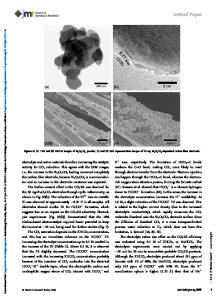Pb 3 (CO 3 ) 2 (OH) 2 Is an Active Phase in Electrocatalytic CO 2 Reduction to Formate
- PDF / 417,249 Bytes
- 2 Pages / 595.32 x 841.92 pts (A4) Page_size
- 84 Downloads / 357 Views
doi: 10.1007/s40242-020-0307-8
Highlight
Pb3(CO3)2(OH)2 Is an Active Phase in Electrocatalytic CO2 Reduction to Formate TAO Zixu and WANG Hailiang* Department of Chemistry, Yale University, New Haven, CT 06511, USA Abstract Determining the catalytically active phase in electrochemical CO2 reduction has been challenging. In their work recently published in Nature Communications on July 8, 2020, Zhang et al. studied the phase transition of a tanninlead(II) complex in electrochemical CO2 reduction and revealed that the in-situ formed hydrocerussite[Pb3(CO3)2(OH)2] is the stable active phase for formate production. This new finding may help settle the debate on the real active site of Pb-based materials for CO2 electroreduction. Catalysis is of great importance to electrochemical CO2 reduction reactions, which have the potential to convert carbon emissions to fuels and chemical products. In some CO2 electroreduction reactions, metal oxide residue on the catalyst surface is considered the active species[1,2]. However, in most cases identifying this metastable oxide layer is challenging. For example, p-block metals, such as Sn and Pb, are known for high formate selectivity in CO2 reduction[3,4], but the identity of the active species is still under debate. While the conventional knowledge is that the metals are catalytically active, some studies have suggested that the real active sites may be oxidized species[5,6]. A recent work by Zhang et al.[7] provides new insights on this topic using a tannin-lead(II)(TA-Pb)
Fig.1
complex as a model system. The TA-Pb complex was found to be highly selective for formate production from electrochemical CO2 reduction with a Faradaic efficiency of 96.4%±0.9% at –0.92 V vs. the reversible hydrogen electrode. The high selectivity was retained for 10 h without deactivation. Through careful examination of the structural changes of the catalyst during potentiostatic electrolysis, the authors discovered that TA-Pb transformed to cerussite(PbCO 3) and then to hydrocerussite[Pb 3(CO3)2(OH)2], which maintained the +2 valence of Pb throughout the electrolysis[Fig.1(A)]. These phase changes were characterized by multiple techniques including X-ray absorption spectroscopy [Fig.1(B)]. Furthermore, synthesized cerussite nanoparticles
Schematic illustration of TA-Pb’s phase transformation during electrochemical CO2 reduction(t-PCO and t-PCOH refer to cerussite and hydrocerussite, respectively, A), X-ray absorption spectra for TA-Pb and its derived phases under CO2 reduction electrolysis(Pb2+ remains unchanged, B), theoretically simulated two-dimensional map of activity and selectivity for electrochemical CO2 reduction and competing hydrogen evolution(only the B-d site shows an obvious HCOOH preference and activity, C) and schematic illustration of hydrocerussite stability difference under reductive CO2 and Ar conditions and consequent electrocatalytic activities(D) All figures are adapted from Ref.[7].
——————————— *Corresponding author. Email: [email protected] Received September 29, 2020;
Data Loading...











